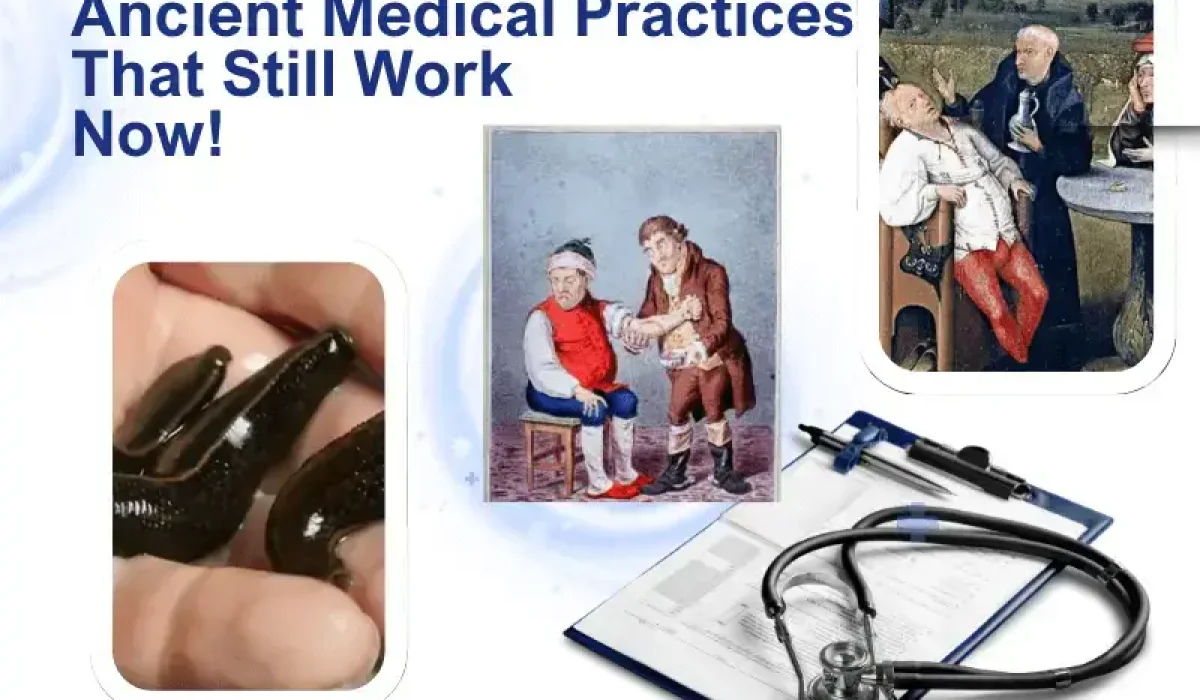For Ancient Medical Practices, Picture this: You’re lying on a hospital bed in 2025. A doctor walks in holding a jar of squirming black creatures. Sounds like a nightmare? Welcome to modern medicine.
Ancient doctors weren’t exactly known for their gentle touch. They drilled holes in skulls. They bled patients dry. They used live animals as medical tools. The truly shocking part? We still do some of these things today.
Table of Contents
The Creepy Truth About Modern and Ancient Medical Practices
Medical science has come far. Or has it? Some of the most horrifying practices from thousands of years ago are still happening in hospitals right now. The only difference? We’ve gotten better at making them sound scientific.
Let’s explore three traditional medical procedures that would have pleased your forefathers. And probably make you squeamish.
1- Leech Therapy: The Bloodsucking Treatment That Never Left
Ancient Origins: When Doctors Were Vampires
Medieval doctors believed bad blood caused illness. Their solution? Attach blood-sucking leeches to patients. Although leeching and regulated bloodletting are still practiced today, the practice eventually lost favor after fresh studies revealed that it might be more harmful than beneficial. Sounds barbaric, right? Wrong. It’s trending.
Modern Reality: FDA-Approved Bloodsuckers
Leeches are a Food and Drug Administration (FDA)-approved treatment to help heal transplanted tissue by reducing blood flow problems. In 2025, hospitals are expected to use medicinal leeches for certain serious procedures.
Here’s what happens today:
- Plastic surgeons use leeches after reattaching fingers
- Microsurgeons who reattach body parts like fingers, toes, thumbs, ears, lips, noses, or even bits of scalp rely on these creatures
- Four research studies support the use of four leeches in each treatment session, whereas six studies suggest using five leeches.
The numbers are astounding. Despite the hazards of flap loss (26,5%), infection (26,5%), and flap necrosis (55,9%), a systematic analysis of 12 trials revealed noteworthy findings.
Why it works: Leech saliva contains natural blood thinners. When tissue is reattached, blood can pool and cause problems. Leeches solve this by creating controlled bleeding.
Want to learn more about FDA-approved medical treatments? Visit the FDA’s official website for comprehensive information.
Patient Experience: “I couldn’t believe it when my surgeon said they’d use leeches on my reattached finger. But it worked. The little guys saved my digit.”
2- Bloodletting: The Ancient Art of Draining Life
Historical Horror: Death by Good Intentions
Ancient physicians believed excess blood caused fever, headaches, and madness. They’d slice open veins and let patients bleed until they felt better. Or died. Whichever came first.
This practice killed more patients than it saved. Yet somehow, it survived.
Modern Twist: Controlled Blood Removal
Today’s doctors don’t use rusty blades. They use sterile equipment and scientific precision. Some of these ‘barbaric’ medical procedures are still used today, such as the life-saving hemochromatosis therapy of bloodletting and the use of leeches as surgical instruments.
Current applications:
- Hemochromatosis treatment (iron overload)
- Polycythemia vera (too many red blood cells)
- Therapeutic phlebotomy procedures
The key difference? Modern bloodletting is measured, monitored, and medically necessary. Ancient bloodletting was… not.
For more information on blood disorders, check out the National Heart, Lung, and Blood Institute
3- Trepanation: Drilling Holes in Heads (Still Happening)
Ancient Skull Surgery: The Ultimate Headache Cure
One of the most horrifying types of surgery is also the oldest in human history. Ancient surgeons drilled holes in skulls to release evil spirits. Or reduce brain pressure. Or just because they could.
Archaeological evidence shows people survived these procedures. Barely.
Modern Craniotomy: Sophisticated Skull Drilling
Today’s neurosurgeons still drill holes in skulls. The difference? They know what they’re doing.
Modern applications:
- Brain tumor removal
- Treating traumatic brain injuries
- Reducing intracranial pressure
- Installing brain implants
The tools have evolved. The fundamental idea is still the same: occasionally fixing the brain requires opening the skull.
Learn more about neurosurgery at the American Association of Neurological Surgeons.
Why These Practices Survived
These treatments didn’t persist because doctors are sadistic. They survived because they worked. Sort of.
The Science Behind the Madness
Ancient doctors stumbled onto biological truths:
- Blood circulation affects healing
- Pressure changes impact brain function
- Natural compounds can treat illness
Modern medicine refined these concepts. We kept what worked. We ditched what killed people.
Cultural Acceptance
Acupuncture, herbal remedies, homeopathy, traditional Chinese medicine, naturopathy, chiropractic, osteopathic, ayurveda, Unani, and indigenous traditional medicine are among the practices utilized globally, according to the WHO Global Report. Traditional practices maintain credibility when they show results.
The Future of Ancient Medicine
What’s next? Researchers are exploring other historical treatments:
- Maggot therapy for wound cleaning
- Bee venom for arthritis
- Plant-based medicines for cancer
The pattern is clear. Ancient wisdom meets modern science. The result? Treatments that sound medieval but work like miracles.
This article is for educational purposes only. Always consult qualified medical professionals before making healthcare decisions.
The following article will also interest you: Artificial Intelligence in Healthcare




